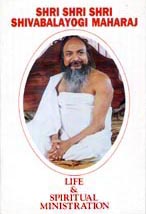![]()
|
|
ABOUT Spiritual Ministration │
PRINTER FRIENDLY PDF
PREVIOUS CHAPTER │
NEXT CHAPTER
Shri Shri Shri Shivabalayogi Maharaj Life & Spiritual Ministration
4.
Completion of Yuga Tapas
3 Tapas of the Four Directions
Download printer-friendly PDF of Spiritual Ministrations
Spiritual Ministration is now published as an
E-BOOK
through Handloom Publishing at Lulu.com
On the day following his attainment of Siddhi of the Southern Direction, the attainment of Dik Sidhi of all Four Directions by the Bala-Yogi was celebrated by ceremonially breaking one thousand and eight coconuts in each direction. This ceremony commenced at 7 a.m. and was completed by midnight. When it was over, the Baja-Yogi broke his ‘Mowna’ by melodiously chanting the ‘Omkar Shabad’.
The next day, at midnight, the Divine Guru again appeared. As the Bala-Yogi had been observing Mowna since 29 October 1953, he had only been able to converse with this Guru in sign language so far. Now that he had broken his Mowna, he could converse with him more freely and easily. That apart, up to now the Bala-Yogi had been completely absorbed in his Tapas, to the exclusion of everything else. Therefore, neither had any doubt arisen in his mind about the true identity of his Guru, nor had it ever crossed his mind to question him about it. As we have mentioned earlier, when the Divine Guru first appeared before him on that fateful day of 7th August 1949, the Baja-Yogi had taken him to be a ‘Sadguru’ of the ‘Jangam Devar’ sect, and he continued to hold onto this belief throughout these first eight years of his Tapas, i.e., up to May 1957, when he attained Dik Siddhi of all the Four Directions. But now a doubt arose in his mind as regards the real identity of his Guru and he proceeded to question him about it.
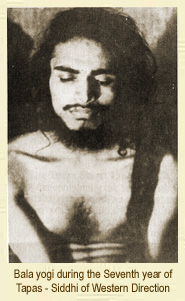 Bala-Yogi: “Who are you? What is your true identity?”
Bala-Yogi: “Who are you? What is your true identity?”
Divine Guru: “Don’t you know who I am?”
Bala-Yogi: “No I don’t; and I am further perplexed by your behaviour and your appearance. You suddenly materialise before me as if out of thin air, and just as suddenly you disappear again. That apart, in your features and to all other respects you look exactly like Shankara Bhagvan; the only differences that I can see between you and Bhagvan are that Shankara Bhagvan has a snow-white complexion, whereas you are dark, and whereas there is Tejas (luminosity) emanating from Shankar Bhagvan, there is no such Tejas emanating from you. I find this quite mystifying and hence a doubt has now arisen in my mind about your actual identity.”
Divine Guru: (with an amused smile) “After all that I have done for you, do you still have a doubt? All right, I will clear your doubt after you complete the full twelve years of the Yuga Tapas.”
As there were still four years left for completion of the Yuga Tapas, the Divine Guru directed the Bala-Yogi to do Tapas for this remaining period facing the East. He also told the Bala-Yogi that from now on he could start initiating aspirants into Dhyana and that he need not continue his present practice of remaining in samadhi for all the 24 hours; just 12 hours a day would suffice.
In accordance with the above directions of his Guru, the Bala-Yogi now started adhering to the following daily routine:—
(a) From 4 a.m. to 4 p.m. he did Dhyana, during which period he was mostly in samadhi.
(b) From 4 p.m. to midnight, he gave Darshan to devotees; during this period Kirtan was also organised at the Dhyana Mandir.
(c) From midnight to 1 a.m. he attended to his ablutions and had his daily bath.
(d) From 1 a.m. to 3 a.m. he would rest.
So far, the Bala-Yogi had restricted his diet to consuming a measured quantity of milk once every day, after his midnight bath. He now started partaking of a milk and fruit diet, twice a day: once at 3 a.m., before sitting for dhyana and the second time at 4 p.m., when he got up from dhyana.
As hitherto, the serpents continued to favour the Bala-Yogi with their attention. One night during this period, a snake entered the Dhyana Mandir while the Bala-Yogi was in samadhi, apparently through the water outlet, and bit him on the hand, tearing away a bit of the flesh in the process. The Bala-Yogi only became aware of this when he got up from samadhi and found his hand bleeding profusely. However, he suffered no ill effects from this bite.
From the earliest days of commencement of Tapas, people used to come to Adivarapupeta in large numbers for the darshan of the Bala-Yogi. Now that he had started giving public darshan the stream became a flood and an ever increasing number of people started thronging the Dhyana Mandir for the daily darshan and kirtan.
The Bala-Yogi had always derived special satisfaction from feeding people; consequently, at his behest, mass feeding of the devotees and the poor was organised regularly every year on 24th January (the Bala-Yogi’s birthday), on Maha-Shivaratri, on 7th August (date of commencement of Tapas) and on many other occasions in between. Like the darshan and the kirtan, mass feeding had also become a regular feature of the activities surrounding the Bala-Yogi from the very earliest days of his Tapas.
Thus Tapas and spiritual ministration continued side by side for the next three and a half years and soon time turned the corner into the year 1961; on 7th August of this year, the Bala-Yogi would complete the full twelve years of his Yuga Tapas.
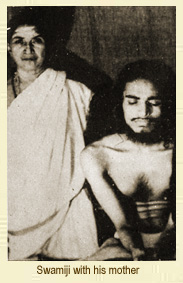 Siddhi of Yuga Tapas
Siddhi of Yuga Tapas
From about January 1961, the Bala-Yogi started losing inclination for even the very restricted diet of milk and fruit that he was taking. First the fruits were deleted and he reverted back to his original pure milk diet. Gradually even this was reduced and soon he had restricted himself to consuming an occasional glass of milk, often only after an interval of many days. On most days he merely drank some water when he went to the well for his daily midnight bath and apparently this seemed to suffice. At the same time, the period of samadhi began to increase again.
Around the beginning of June 1961, the Bala-Yogi became absorbed in continuous Nirvikalpa Samadhi which lasted unbroken for two full months, i.e., for the whole of June and July 1961. At midnight of the 1st of August 1961, the Divine Guru came and aroused the Bala-Yogi from his deep samadhi. When he saw that the Bala-Yogi had returned to normal consciousness, the Divine Guru smiled and said: “You had a doubt about my true identity, didn’t you? All right now watch closely.”
As he said these words a dazzling light, like lightning, flashed forth from the Guru’s body and instead of the dark hued Jangam Devar, there stood before him the snow-white and bewitching form of his Ishta Dev, Shankar Bhagvan. It was thus revealed to the Bala-Yogi that his Divine Guru had been no other than Shankar Bhagvan himself, who used to come and guide him in the guise of a Jangam Devar.
Having cleared the Bala-Yogi’s doubt on this point, Shankar Bhagvan and Mother Parvati, who had accompanying him, sat on the Dhyana Platform and began to converse affectionately with the Bala-Yogi, whom they looked upon both as their disciple and their child. Shankar Bhagvan told the Bala-Yogi that his period of Tapas was over and he was now free to roam at will and to act as it pleased him: “You may go wherever you like and do whatever you wish to,” said Bhagvan. To this the Bala-Yogi replied that he had no wish to go anywhere or to do anything in particular.
“Do you have any wish in mind?” Shambhu then inquired, “You may ask for anything and it shall be granted to you.” Again the Bala-Yogi replied that he desired nothing at all and that he would do whatever Shankar Bhagvan wanted him to do.
Well pleased with this answer, Shankar Bhagvan complimented the Bala-Yogi on his steadfastness in Tapas and then told him that henceforth his mission would be to rouse the dormant spirituality of the people in general, and to help sadhakas (aspirants) who were struggling on the spiritual path to gain liberation from the yoke of Samsara. To this end, he should travel around and give darshan to people; such darshan would help in weaning them away from the materialistic to the spiritual path. He should initiate aspirants into the secret and mystic path of Dhyana Yoga and guide them so that they are able to gain liberation in this very life. He should give so-lace to those who grieved and heal those who suffered from the myriad afflictions of the mind and the body; this process of healing should be effected by giving the sufferers sacred vibhuti, which should be blessed and consecrated by him for this purpose.
Shankar Bhagvan then told the Bala-Yogi that henceforth he should use the name ‘Shiva Bala Yogeshwara.’ (Bala is another name for Mother Parvati, so the name signified “the Lord of Yogis”, devoted to Siva and Parvati). Later, the Bala-Yogi on his own changed the name given to him by Shiva to ‘Shiva Bala Yogi Maharaj’ as he felt that the use of the title ‘Yogeshwara’ in the name might be misunderstood by many to imply that he was being equated with ‘Ishwara’, the Supreme Lord.
Finally, Shankar Bhagvan told his disciple that he would make him sit for Tapas from time to time, as the need arose in future. Then giving their blessings and bidding an affectionate farewell, Shankar and Bhavani disappeared. It is significant that Sri Sivabalayogi Maharaj, from that day, started exhibiting in his own body the ‘Ardhanarishwara Swarup’,* i.e., one half of his body shows the characteristics of a man and the other half has many characteristics peculiar to a woman, thus signifying in his own person the union of Parvati and Parameshwara.
* [This term means: ‘Half God-Half Goddess Form’.
This is one of the forms of Shankar in which one half of His body appears as Shiva and the other half as
Parvati:
this form signifies the union of Parvati and Parmeshwar, i.e. the Supreme Lord and His
Shakti.]
As the day for completion of the Yuga Tapas by the Bala-Yogi drew near, thousands of people began streaming into Adivarapupeta for the darshan of the Yogi. By the morning of 7th August 1961, a vast crowd numbering well over three hundred thousand had assembled in and around the Dhyana Mandir and they waited in joyous expectation for the Yogi to emerge. At 8 that morning, the Bala-Yogi, or Shri Shri Shri Shivabalayogi Maharaj as he was now named, marked the completion of the twelve year period of Yuga Tapas by chanting the ‘Omkar Shabad’ in a melodious voice. The doors of the Dhyana Mandir were then thrown open and he was escorted to a high wooden platform, which had been especially constructed for this occasion. As he emerged from the Dhyana Mandir, a mighty roar went up from the assembled multitude. Unused as he was to walking. and considerably weakened by lack of nourishment during the two month long samadhi, Shri Shivabalayogi Maharaj had to be helped up onto the darshan dais. Then, as the Yogi came into full view of the vast assembly, thunderous cheering broke out and the countryside reverberated to the ecstatic “Jai Jaikars” that issued forth from three hundred thousand throats. This adoration of his devotees nearly sent the Yogi into samadhi again and he had to be literally held up to prevent him from falling. Standing there with eyes closed, in a semi-conscious state of spiritual ecstasy, Shri Shivabalayogi Maharaj silently showered his blessings on the people who had assembled for his darshan. And as the crowd pushed and jostled to get a closer view of the Mahatma, they saw standing before them a Yogi whose body, though emaciated and almost deformed by the rigours of his intense Tapas, nevertheless shone with a strange lustre and visibly exuded peace and spiritual grace.
Establishment of Adi-Ashram
After the completion of the Yuga Tapas. Shri Shivabalayogi Maharaj felt no immediate inclination to go anywhere and so he continued to reside for the time being at Adivarapupeta. The work of spiritual ministration, which had commenced immediately after the Yogi attained Dik Siddhi of the Four Directions in May 1957, now acquired added impetus as people began coming for the Yogi’s darshan in ever increasing numbers. A need was soon felt to organise a proper Ashram, so the area surrounding the Dhyana Mandir was acquired, a compound wall built and thus a regular Ashram came into being; this is now the Adi Ashram of the Shri Shri Shri Shivabalayogi Maharaj Trust. An Ashram Committee was also formed which was made responsible for organising the daily Darshan, Kirtan, Dhyana Diksha and other Ashram activities.
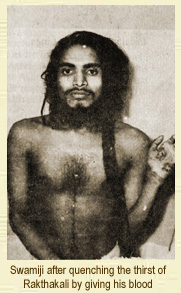 The Propitiating of Raktha Kali
The Propitiating of Raktha Kali
On 19th January 1962 a family from Rajamundhry came for the darshan of Shri Swamiji. They brought along with them their teenaged daughter, aged about 18 years, who appeared to be in a trance-like state. The parents explained to Shri Swamiji that their daughter was an ardent devotee of Mother Kali and that lately she had been keeping ‘Upwas’ (total abstention from food) as a part of her worship of the Mother. A day or so earlier, the girl suddenly went into a trance and started asking for blood to quench her thirst. Naturally, this strange behaviour of their daughter frightened the parents and so they had brought the girl to Shri Swamiji. While the parents were explaining all this to Shri Swamiji the girl sat quietly, reclining against the wall at the back. All of a sudden, like one jolted by an electric current, the girl was jerked into an erect posture. Then, like one possessed, she started grinding her teeth in a violent and frightening manner and began swinging her body from side to side. It was apparent from her behaviour that she had lost her normal consciousness and had become totally unaware of her surroundings. As she obviously appeared to be possessed, a devotee sitting nearby asked her who she was? In a thundering voice she replied: “I will not tell; who are you?” When the devotee concerned announced his own identity, the girl stated that she was Somalamma, known as Shyamalamba of Rajamundhry; that she had now come as Raktha Kali; that she would first devour herself then kill the people of Adivarapupeta including the Swamiji and then she would devastate the whole country; only thus could her present consuming thirst for blood be satisfied. Shri Shivabalayogi Maharaj, who had been watching and listening quietly all this while, now addressed Raktha Kali in the person of the girl; he assured her that he would give her all the blood she required to quench her thirst, so she should leave the devotees alone and come to him. He then extended his left aim for Raktha Kali to slake her thirst. With a vicious smile, Raktha Kali seized his arm and bit into the extended palm of his left hand. Blood spurted out from the palm and Raktha Kali began to suck it greedily as though she were tormented by an insatiable thirst. This blood drinking went on for almost two hours and, all this while, Shri Swamiji continued to quietly converse with her. In reply to one of his questions, Raktha Kali said that his blood was sweet as nectar and that she had quenched her thirst for the next two thousand years. Finally, Raktha Kali appeared satisfied and was pleased; she blessed Shri Swamiji, bestowed all her powers on him and took her leave. Immediately this happened, the girl became her normal self again.
Sthapana of Siva Linga
At the behest of the devotees, Shri Swamijj agreed to install a Shiva Linga and an icon of Mother Parvati in the Dhyana Mandir, to commemorate according to religious tradition, the place where he had done his Tapasya. Soon after this decision was taken, a beautiful Shiva Linga appeared before Sri Swamiji in his dhyana; it was simultaneously revealed to him that this was the Shiva Linga meant for installation in the Dhyana Mandir and that it would be found in the Narmada River, near the Sangam (confluence) that adjoins the famous Omkareshwar Temple. On the basis of this revelation Sri Swamiji briefed two devotees, Gauri Shankar and Satya Narain Reddy, on how and where to find the Shiva Linga and dispatched them to the Narmada River with instructions to locate the Shiva Linga and bring it back with them. In spite of an intense search, these devotees could not find a Shiva Linga conforming to the description given by Shri Swamiji and so they were compelled to return empty handed.
When these devotees failed to find the Shiva Linga, Sri Swamiji summoned Sadhu Narain Das, an initiated disciple of Tapaswiji Maharaj. He gave him an exact description of the Shiva Linga and this time, in order to ensure that Narain Das would succeed in his mission, Sri Swamiji instructed him to sit in dhyana on the banks of the Narmada, opposite the Sangam near the Omkareshwar Temple; Sri Swamiji assured Narain Das that the location of the Shiva Linga would be revealed to him in his dhyana. With high hopes, Sadhu Narain Das left for the Narmada River and, as instructed by Sri Swamiji, sat in dhyana at the place he had indicated. Though he continued to sit thus for twenty days running, no revelation came and he felt thoroughly dejected at the thought of having to go back without accomplishing his task. Rather than return empty handed, he decided that he would select a Shiva Linga of his own choice and take it along when he went back. Looking around, he soon found a beautiful Shiva Linga, with a natural luster emanating from it, and so he picked it up to take back with him as a substitute for the one he had failed to find.
Though Sadhu Narain Das was somewhat consoled at having found a good substitute Shiva Linga, the thought that he had failed to find the Shiva Linga described by Sri Swamiji continued to weigh on his mind; this made him sad at heart. On the night before he was due to leave, Sadhu Narain Das felt restless and unhappy and so he strolled across to the spot where he had sat in dhyana all these days. The thought of his failure continued too press his mind and he sat staring out at the River in a disconsolate mood. As he watched the dark waters of the River tumbling and gurgling past, his mind soon became calm and peaceful and he went into deep dhyana; suddenly, he had the vision of ‘jyoti’ (light) and felt that this jyoti was emerging from within him and lighting up the whole area around. Startled by this vision, he opened his eyes and saw that a ray of brilliant light was actually emanating from his forehead and was being beamed towards the centre of the River. Looking along this beam of light, Sadhu Narain Das saw to his joy and wonder that the light was playing upon a beautiful Shiva Linga that was bobbing up and down on the water, in the centre of the River, reflecting back brilliant hues of silver and gold. With a throbbing heart Sadhu Narain Das waded out into the River and though the Shiva Linga was rather heavy (under normal circumstances at least 2-3 men are required to lift it), he found no difficulty in picking it up and bringing it out. Next day, with a joyful heart, he left for Adivarapupeta with both the Shiva Lingas: This sacred Shiva Linga, revealed to Sri Swamiji in his dhyana and found by Sadhu Narain Das in mysterious elevating circumstances was installed by Shri Swamiji in the Dhyana Mandir on the Maha Shivaratri of 1962, (25th February 1962). He consecrated the Lingam by the power of his Tapas, thereby making it an awakened and living manifestation of the Great God Shiva. This ‘Svayambhu Linga’ (self manifested Linga), also known as Atmalinga, has a silver sheen on one side and a golden sheen on the other; the silvery coloring is representative of the snow-white complexion of Siva and the golden colouring is representative of the golden complexion of Mother Parvati; thus this Siva Linga exhibits the Ardhanarisvara Swarup of Shankar Bhagvan.
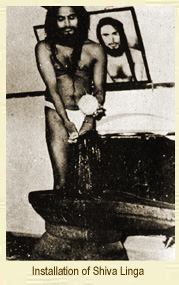 Installation of Parvati Murthy
Installation of Parvati Murthy
While the search for the Shiva Linga was going on, an icon of Mother Parvati which had been specially commissioned for the Adivarapupeta Ashram was being sculptured in Mysore. The installation ceremony of this ‘Murthy’ (statue) was scheduled to take place immediately after the Sthapana of the Shiva Linga on 25th February 1962, i.e., on the Maha Shivaratri Night.
On the night of 24th February 1962, i.e., on the night previous to the installation, Sri Swamiji was sitting along in the Dhyana Mandir when Bhavani (another name for Parvati) appeared before him and demanded that two blood sacrifices be performed to propitiate Her during the installation ceremony. But Sri Swamiji promptly refused; reverently though firmly he informed the Mother that a blood sacrifice was not acceptable to him and hence no blood sacrifice would be performed within the precincts of the Ashram. At this, Mother Bhavani simply smiled and vanished. As subsequent events will show, the Mother was determined to have Her own way in spite of the objections of Her recalcitrant son.
On the day of the installation ceremonies, i.e., on the Maha Shivaratri Day of 1962, people began arriving at Adivarapupeta from early morning onwards and, as the day wore on, a vast multitude had congregated at the Ashram. At about 4 p.m. in the afternoon, a stout sadhu arrived with his party to witness the installation ceremony. ‘Kirtan’ (devotional singing) was going on at that time and a large number of devotees, lost to the outer world in ‘Bhava Samadhi’,* were dancing ecstatically to the beat of the devotional music. The sadhu observed all this for sometime and then announced with a sneer, to all those who would care to listen, that these people who were supposedly in Bhava Samadhi were in fact humbugs and were faking this condition to attract attention to themselves. To prove his point more emphatically, the Sadhu struck the man nearest to him with one of his wooden sandals. By this somewhat drastic action, the Sadhu obviously hoped to deflate the person and thereby expose what he assumed to be mere pretence on his part. Unfortunately for the Sadhu, the man he struck happened to be in ‘Hanuman Bhava.’ This man immediately snatched the same wooden sandal from the sadhu’s hand and retaliated by striking the Sadhu a resounding crack on the head with such tremendous force that the Sadhu’s head split open and he fell unconscious to the ground. This caused an immediate commotion as people crowded round to see what had happened. The Sadhu was some-how extricated from the crowd and carried in that unconscious state to Sri Swamiji. Blood was pouring from the Sadhu’s head in a copious stream and as soon as Sri Swamiji saw the sudhu, he recalled Bhavani’s demand for a blood sacrifice. He was rather upset and remonstrated with the Mother saying, “I told you there should be no blood sacrifice in the Ashram and now look what you have done!” Sri Swamiji then liberally applied consecrated vibhuti to the wound and tightly bound up the Sadhu’s head. This saved the Sadhu’s life and, after sometime, he regained consciousness.
* [See Chapter 8.]
Later that night, as Sri Swamiji sat alone in the Ohyana Mandir, Bhavani again appeared before him and told him that she was thirsty, and that she wanted blood to quench Her thirst.
“Haven’t you had enough?” asked Sri Swamiji. “See how much blood that poor man lost.”
“No,” said Bhavani, “only half my thirst has been quenched; I want more blood”.
“In that case,” said Sri Swamiji, “I will give all the blood you want. Please leave the devotee alone.”
He then extended his left hand; Bhavani bit into his left fore arm and with great relish started sucking the blood that began to flow out. Eventually, as it approached midnight, Sri Swamiji requested Bhavani to let him go as the time for the installation ceremonies was approaching. Thereupon Bhavani smiled and blessing her Yogi son, she disappeared.
The unique and mysterious circumstances attendant on the installation of the Shiva Linga and the Murthy of Mother Parvati, which have been related above, are a clear proof that Shankar and Bhavani are manifest in the Dhyana Mandir as living presences. Therefore, to obtain darshan of the Dhyana Mandir and the deities installed therein, is in itself a great blessing.
